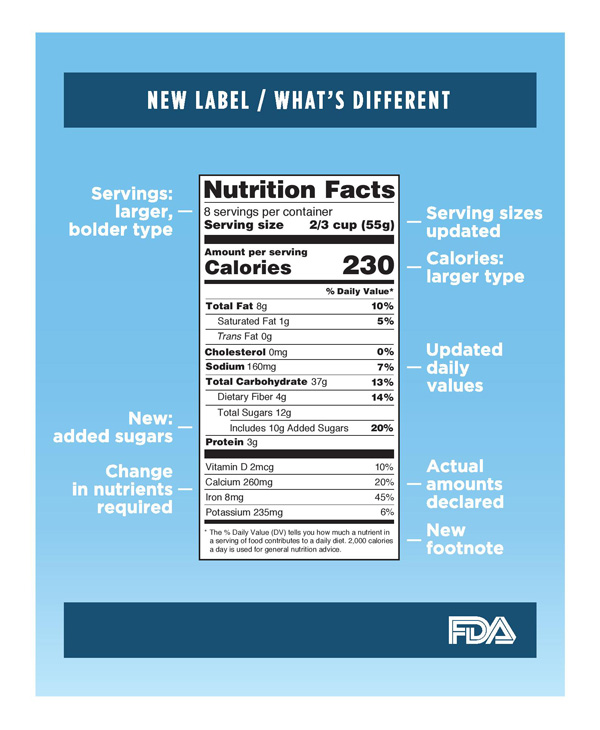The US Food and Drug Administration’s (FDA) new Nutrition Facts label was recently unveiled by First Lady, Michelle Obama. While the updated label will help consumers make better choices at the grocery store, the changing regulations could be a nightmare for the sugar industry.
As the current Nutrition Facts label is over 20 years old, the FDA made the changes in an effort to make the label more reflective of current eating habits in the US. New research on how certain ingredients in food – including sugar and fat – contribute to chronic disease, and the prevalence of vitamin deficiencies across the country, were also used to inform the FDA’s label changes.
So what are the key changes mandated by the FDA, and how will they impact food manufacturers?
Added Sugars
Perhaps the most difficult rule for food manufacturers to comply with is the one which concerns added sugar. So-called added sugars – defined by the FDA as natural sugars which are added during the processing of foods – are represented in both grams, as well as percent daily value on the new Nutrition Facts label.
While this added sugars labelling requirement does not include artificial sweeteners, it will apply to many other sources of sugar. Free sugars, monosaccharides, disaccharides, syrups and honey, will all be required to be listed on the label. In addition, sugars from concentrated juices – such as those made from fruits and/or vegetables – that exceed the amount expected to be in non-concentrated 100 percent juice, will be required to be reported on the label.
The decision to include the added sugars on the new Nutrition Facts label, was based on the amount of sugar currently consumed in the US, and its effects on public health. According to the market research firm, Euromonitor, the average US citizen consumes the equivalent of just over three 12-ounce cans of Coca-Cola – amounting to 126 grams of sugar – on a daily basis. This number is more than double the average sugar intake of 54 other countries, including Britain and Canada.
“The FDA recognizes that added sugars can be a part of a healthy dietary pattern,” said a regulatory document released by the FDA. “But if consumed in excess, it becomes more difficult to also eat foods with enough dietary fiber and essential vitamins and minerals and still stay within calorie limits.”
The FDA said that meeting nutritional needs and staying within a daily calorific intake is difficult if over 10 percent of person’s daily calories come from sugar. The regulatory agency said the average American today gets 13 percent of their total calories from added sugars.
“The updates to the label will help increase consumer awareness of the quantity of added sugars in foods,” the FDA continued. “Consumers may or may not decide to reduce the consumption of certain foods with added sugars, based on their individual needs or preferences.”
Food Industry Reaction
While food manufacturing giants such as Mars and Nestle have supported the FDA’s measure to require added sugars on the new Nutrition Facts label, most other companies in the food industry have been vehemently against the change. Among them is The Sugar Association, which represents the interests of the US sugar industry.
“The Sugar Association is disappointed by the FDA ruling to require an ‘added sugars’ declaration and daily reference value on the Nutrition Facts label,” said The Sugar Association in a statement. “The extraordinary contradictions and irregularities, as well as the lack of scientific justification in this rulemaking process are unprecedented for the FDA.”
Since the FDA began to consider changes to the Nutrition Facts label in early 2014, major food organizations – including the American Bakers Association, Corn Refiners Association and the American Beverage Association – fought to keep added sugars off the food label. They argued that there is not enough scientific evidence linking sugar to disease, and even small amounts of added sugar would be unfairly vilified, if they were required to be included on the label.
Two years later, these same organizations have lost the battle and will be forced to comply with the impeding label changes. While perhaps not as controversial as the added sugars section, the FDA has made both content and design-related changes to the updated Nutrition Facts label.
Additional Label Changes
In addition to the added sugar section, the updated Nutrition Facts label contains some small, but important design changes. The new label features increased type size for calories, servings per container, and serving size. In addition, both calories and serving size texts will be bolded to further highlight this information.
Food manufacturers will be required to declare both the actual amount and the percent daily value for vitamin D, calcium, iron and potassium. In order to help consumers better understand what the percent daily value really means, the FDA has changed the footnote at the bottom of the label to, “The % Daily Value tells you how much a nutrient in a serving of food contributes to a daily diet. 2,000 calories a day is used for general nutrition advice.”
Vitamin D and potassium are new mandatory additions to label, which the FDA says is reflective of the most common vitamin deficiencies in the US. In contrast, vitamins A and C will no longer be required on the Nutrition Facts label, but food companies may decide to list these nutrients on a voluntary basis.
As nutritional beliefs regarding the impact of fat on health have changed in recent years, the FDA has removed calories from fat from their new label. Total fat, saturated fat and trans fat will still be required to be listed on the label, because the FDA says the type of fat in a food product is more important that it’s caloric load.
The same updated scientific reports used to inform the 2015-2020 Dietary Guidelines for Americans, were used to update the daily recommended values for sodium, vitamin D and dietary fiber. These figures will allow food manufacturers to calculate the percent daily value for these nutrients in their products.
Serving sizes are also being updated since their last re-evaluation in 1993. By law, serving sizes must be reflective of the actual amounts of a food product people eat, so the FDA is increasing serving sizes for some products, and decreasing them for others.
Since package size can have an effect on how much someone eats, the FDA is requiring that packages consisting of one to two servings list the total values for calories and other nutrients present in the whole package. The same will be required for products that are not technically one serving size – such as a pint of ice cream – but could potentially be consumed in a single sitting.
The new Nutrition Facts label requirements will affect all food companies in the US, as well as international food manufacturers who export and market their products in the US. Many food manufacturers will have until July 26, 2018 to comply with the regulations, while companies whose annual sales are under $10 million, will have an additional year to adopt the new label design.
Whether the new Nutritional Facts label will influence consumers to buy products lower in sugar, thereby pushing food manufacturers to reduce the amount of added sugars in their products, has yet to be seen. What’s clear is that food companies that use substantial amounts of added sugars in their products, will need to evaluate how the labelling requirements could affect product sales.
Take our poll , What The FDA’s New Nutrition Facts Label Means for Food Manufacturers https://xtalks.com/fdas-new-nutrition-facts-label-poll/
What do you think about the FDA’s new Nutrition Facts label? Will the new labelling requirements have an impact on your food business? Share your thought in the comments section below.








Join or login to leave a comment
JOIN LOGIN